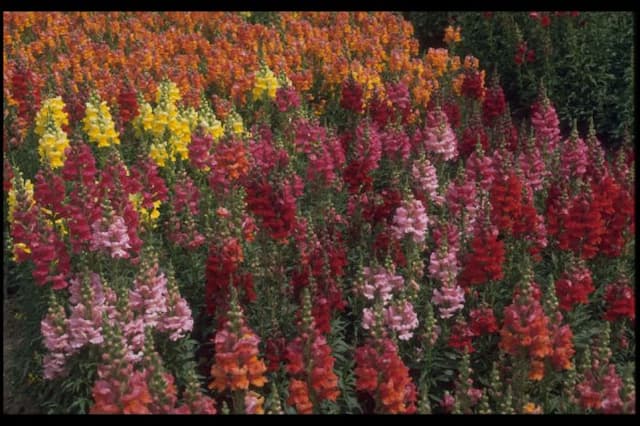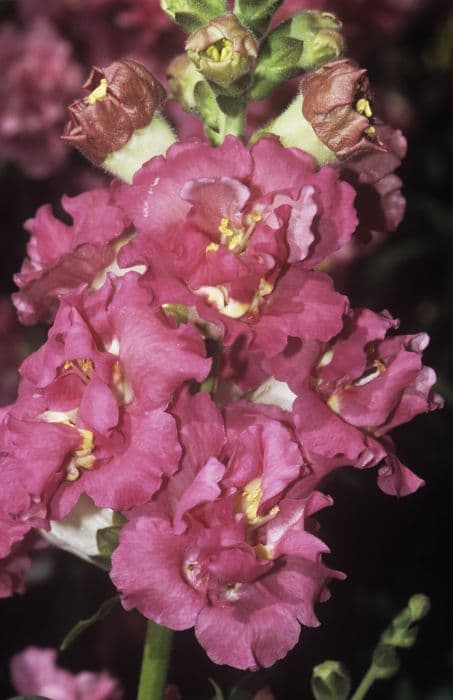Beardtongue Penstemon 'Geoff Hamilton'

ABOUT
Penstemon 'Geoff Hamilton' is a beautiful perennial plant known for its attractive flowers and foliage. The plant bears numerous bell-shaped flowers that come in a soft pink hue, which provides a delightful contrast against the dark green leaves. The flowers are arranged in panicles and bloom profusely, creating a dense and colorful display. The leaves of Penstemon 'Geoff Hamilton' are lance-shaped, with a glossy texture and a slightly serrated edge, which gives the foliage a lush appearance. The overall shape of the plant is upright and bushy, forming a mound-like structure with stems that are both sturdy and elegant. The blooms, which are loved by pollinators like bees and hummingbirds, appear from late spring to early summer. The plant continues to provide visual interest even when not in flower, making it a staple in many gardens for its enduring beauty throughout the growing season.
About this plant
 Names
NamesFamily
Plantaginaceae
Synonyms
Beardtongue, Geoff Hamilton Penstemon
Common names
Penstemon 'Geoff Hamilton'.
 Toxicity
ToxicityTo humans
The Beardtongue is not known to be toxic to humans. However, as with any plant not intended for consumption, ingesting it may potentially cause discomfort or an allergic reaction in some individuals. If symptoms such as stomach upset, vomiting, or diarrhea occur after ingesting part of the plant, seek medical attention.
To pets
The Beardtongue is not considered to be toxic to pets. It does not typically cause serious harm if ingested by animals such as dogs and cats. However, gastrointestinal upset is a possible reaction in some pets with sensitive stomachs or those who ingest large quantities of the plant. If signs of distress or unusual behaviors occur after ingestion, it is advisable to consult a veterinarian.
 Characteristics
CharacteristicsLife cycle
Perennials
Foliage type
Deciduous
Color of leaves
Green
Flower color
Pink
Height
2 feet 60cm
Spread
2 feet 60cm
Plant type
Herb
Hardiness zones
5
Native area
North America
Benefits
 General Benefits
General Benefits- Attracts Pollinators: The Penstemon 'Geoff Hamilton', also known as Beardtongue, is known for attracting bees, butterflies, and other beneficial pollinators to the garden, which can help increase the pollination of surrounding plants.
- Drought Tolerant: Once established, this variety is drought tolerant, making it suitable for xeriscaping or for gardens in areas with low rainfall.
- Low Maintenance: Beardtongue plants do not require regular fertilization or pruning, which makes them easy to care for and ideal for busy or low-maintenance gardeners.
- Long Flowering Period: Penstemon 'Geoff Hamilton' has a long blooming season, often from late spring to early fall, providing continuous color and interest in the landscape.
- Cold Hardy: This plant is known for its hardiness and can survive in colder climates, down to USDA Hardiness Zones, which makes it suitable for many temperate gardens.
- Ornamental Value: With its attractive foliage and tubular flowers, the Penstemon 'Geoff Hamilton' adds ornamental value to garden borders, flower beds, and as a part of mixed perennial displays.
- Erosion Control: Its root system can help stabilize soil and reduce erosion on slopes or in areas with loose soil.
- Versatile Planting Options: It can be used as specimen planting, in rock gardens, and can adapt to various soil types, although it prefers well-drained soils.
- Habitat Enrichment: By providing nectar and habitat, it supports the local ecosystem by sustaining various insects and birds.
 Medical Properties
Medical PropertiesThis plant is not used for medical purposes.
 Air-purifying Qualities
Air-purifying QualitiesThis plant is not specifically known for air purifying qualities.
 Other Uses
Other Uses- Artistic inspiration – The striking flowers of the Penstemon can be a beautiful subject for painters and photographers looking to capture the beauty of nature.
- Educational tool – Botany or horticulture students can study the Penstemon's growth patterns, flower structure, and pollination strategies as part of a hands-on learning experience.
- Dye production – Although not commonly known for this, the Penstemon's flowers could potentially be used to create natural dyes for textiles or crafts.
- Floral arrangements – The long-lasting blooms make an excellent choice for cut flower arrangements, adding height and color to bouquets or indoor displays.
- Ecosystem services – Penstemon plants can be integral to a garden's ecosystem, providing nectar for pollinators like bees and hummingbirds.
- Symbolism and gifting – Certain cultures or individuals may use the Penstemon as a symbol in ceremonies or as gifts to represent appreciation for natural beauty or gardening achievements.
- Theme gardens – They can be a highlight in a color-themed garden or a cottage garden, where their vibrant colors add to the overall aesthetic.
- Natural markers – Penstemon plants, because of their distinct form, can be used in garden design as natural markers to delineate pathways or garden sections.
- Culinary decoration – Although not commonly consumed, the flowers can be used as an edible garnish for salads or desserts to add a splash of color (but only if you're sure of its edibility and absence of pesticides).
- Biological studies – The Penstemon can serve as a subject for scientific research on plant hybridization and adaptation due to its many cultivars and varieties.
Interesting Facts
 Feng Shui
Feng ShuiThe Beardtongue is not used in Feng Shui practice.
 Zodiac Sign Compitability
Zodiac Sign CompitabilityThe Beardtongue is not used in astrology practice.
 Plant Symbolism
Plant Symbolism- Strength: Penstemons are known for their strong stems and hardy nature, symbolizing resilience and endurance.
- Beauty: With their attractive tubular flowers, penstemons represent the appreciation of natural beauty.
- Diversity: Available in various colors, the penstemon variety 'Geoff Hamilton' represents diversity and the celebration of differences.
- Attraction: The flowers are known to attract hummingbirds and butterflies, symbolizing allure and magnetism.
- Healing: In some traditions, penstemons have been associated with medicinal properties, symbolizing health and healing.
- Openness: The open flower design can symbolize an open heart and mind, receptive to new ideas and experiences.
 Water
WaterBeardtongue, including the variety 'Geoff Hamilton,' should be watered deeply once a week, allowing the soil to dry out somewhat between waterings. During hot, dry periods, increase watering to twice weekly, providing about 1 to 1.5 gallons per plant depending on the size and environmental conditions. It's important to avoid overhead watering to prevent leaf and stem diseases; instead, water at the base of the plant. Over the winter months, reduce watering as the plant goes dormant. Always ensure good drainage as beardtongue does not like to sit in wet soil.
 Light
LightBeardtongue thrives in full sun to partial shade, with a preference for a sunny spot where it can receive at least 6 to 8 hours of direct sunlight per day. In regions with very hot summers, afternoon shade can help prevent scorching. This plant is adaptable but will produce the most abundant blooms when positioned in a location with ample sunlight.
 Temperature
TemperatureBeardtongue is hardy and can withstand a wide range of temperatures, but it grows best when daytime temperatures are between 60 and 85 degrees Fahrenheit. It can survive minimum winter temperatures down to about -30 degrees Fahrenheit. Protect from extreme cold with mulch or consider moving potted specimens to a sheltered location.
 Pruning
PruningPrune beardtongue to remove spent flower spikes and encourage a second bloom. The best time for pruning is immediately after the first flowering has concluded. Pruning in late autumn or early spring can help maintain the plant's shape and remove any winter-damaged foliage.
 Cleaning
CleaningAs needed
 Soil
SoilBeardtongue 'Geoff Hamilton' prefers well-draining soil with a pH ranging from slightly acidic to neutral. A mix of loam, coarse sand, and compost is ideal, ensuring good drainage and fertility. Aim for a soil pH between 6.0 and 7.0 for optimal growth.
 Repotting
RepottingBeardtongue 'Geoff Hamilton' doesn't require frequent repotting and can often be left undisturbed for several years. Repot every 3 to 4 years to refresh the soil and accommodate growth.
 Humidity & Misting
Humidity & MistingBeardtongue 'Geoff Hamilton' is tolerant of a wide range of humidity conditions. Average room humidity is typically sufficient, as the plant is quite adaptable in this regard.
 Suitable locations
Suitable locationsIndoor
Place in bright indirect light, minimize watering in winter.
Outdoor
Choose sunny spot, protect from harsh winds, well-drained soil.
Hardiness zone
5-9 USDA
 Life cycle
Life cycleThe life of the Penstemon 'Geoff Hamilton', commonly known as Beardtongue, begins with seed germination, typically in the spring when soil temperatures warm. As a perennial, the Beardtongue then develops a rosette of leaves at the soil surface, from which stems will grow and mature. During the late spring to early summer, the plant produces tall spikes adorned with tubular flowers that are attractive to pollinators like bees and hummingbirds. After fertilization, seeds develop and are eventually dispersed near the parent plant. Throughout the summer, Beardtongue continues to grow and can be propagated by division or cuttings. As temperatures cool in the fall, the plant enters dormancy, where above-ground growth dies back, and the plant overwinters with its root system until the next growing season.
 Propogation
PropogationPropogation time
Spring-Early Summer
The Penstemon 'Geoff Hamilton', commonly known as beardtongue, can be propagated through several methods, but one of the most popular is by cuttings. Cuttings are typically taken during the late spring or early summer when the plant is actively growing. To propagate by cuttings, select a healthy stem with new growth and cut a 4 to 6-inch (10 to 15 cm) piece, just below a node. Strip the lower leaves and dip the cut end into a rooting hormone. Then, insert the cutting into a pot filled with a mix of peat and perlite or a well-draining potting soil. Make sure to keep the soil consistently moist and place the pot in a warm area with indirect sunlight until roots have developed, which usually takes a few weeks. Once the cuttings have rooted, they can be transplanted into their permanent location in the garden.





![Snapdragon [Pretty in Pink]](/_next/image?url=https%3A%2F%2Fplants-admin.emdemapps.com%2Fimages%2Fplants%2F%2Fimages%2F604b5cb3b5385.png&w=640&q=75)



